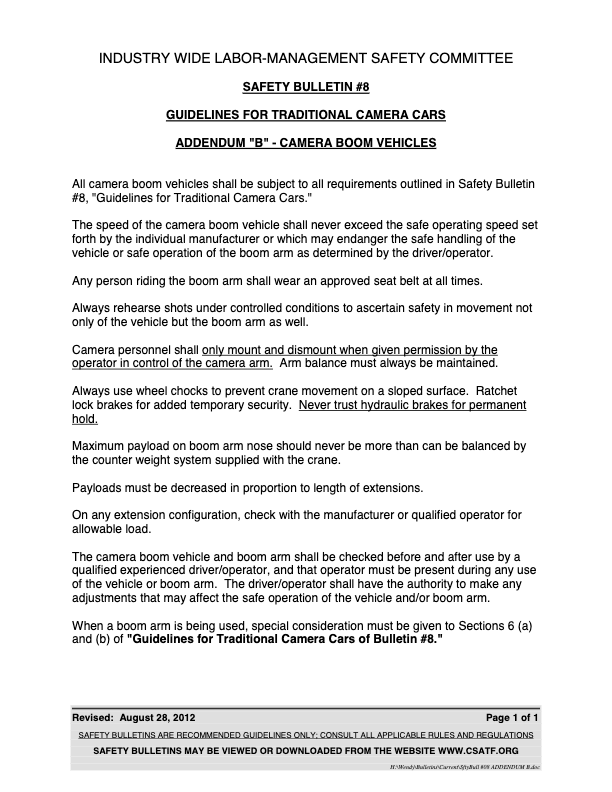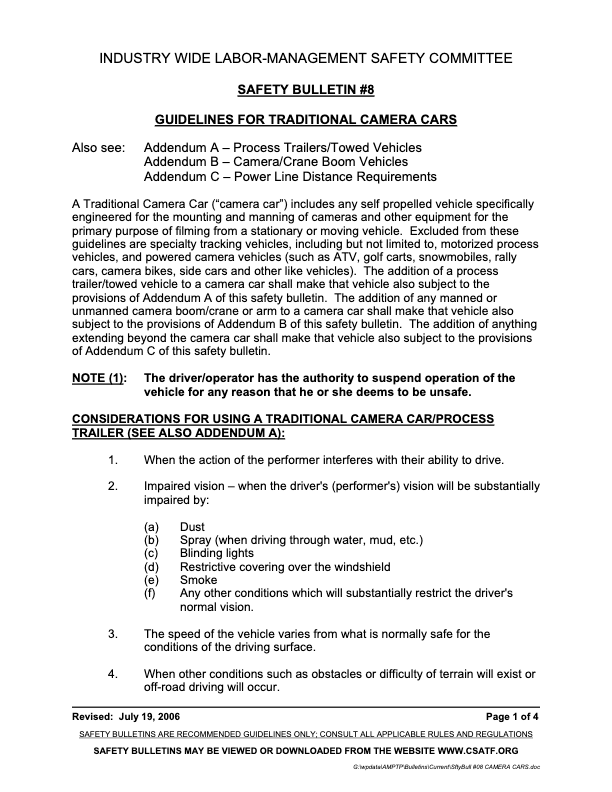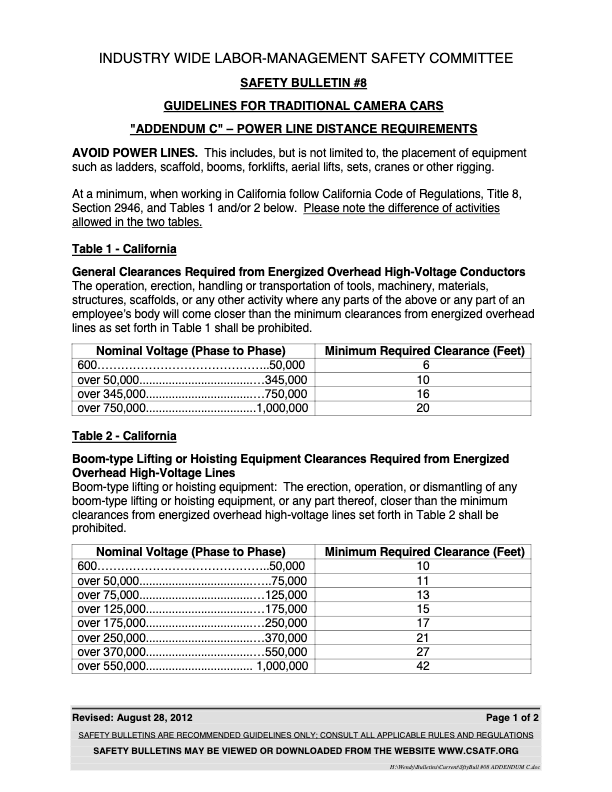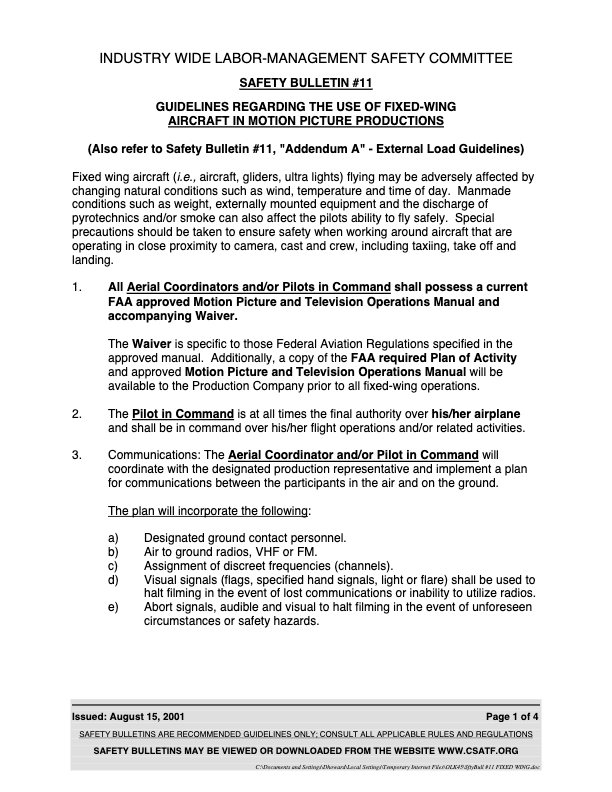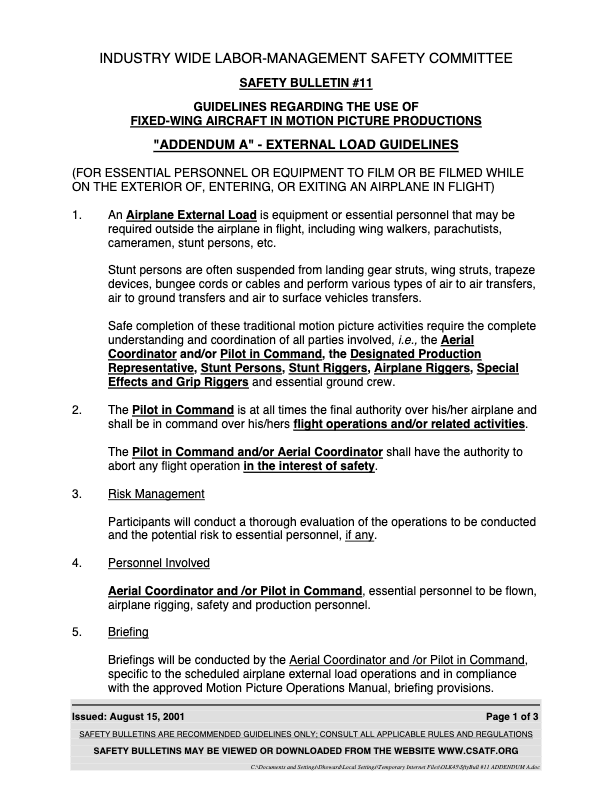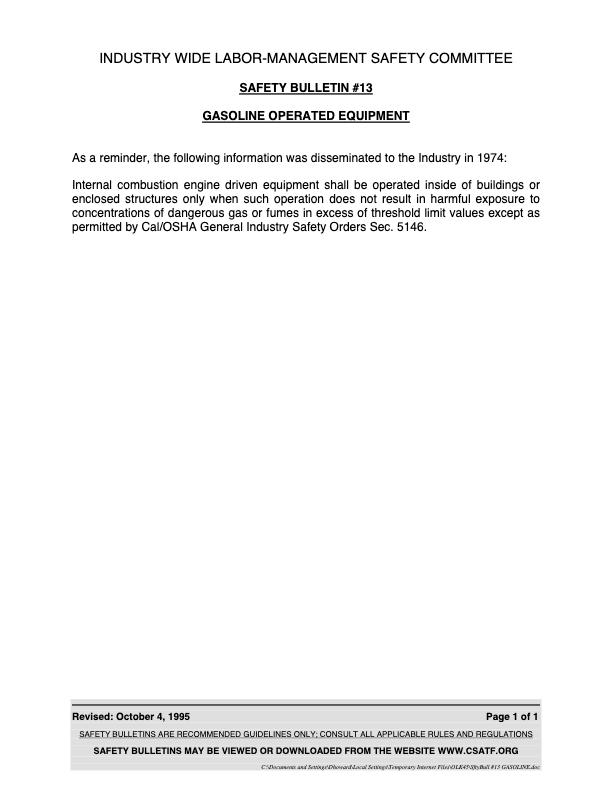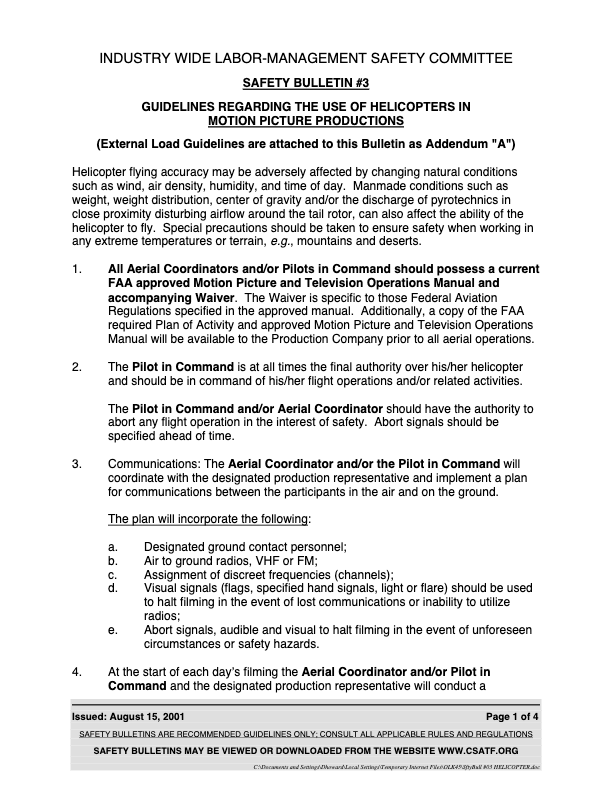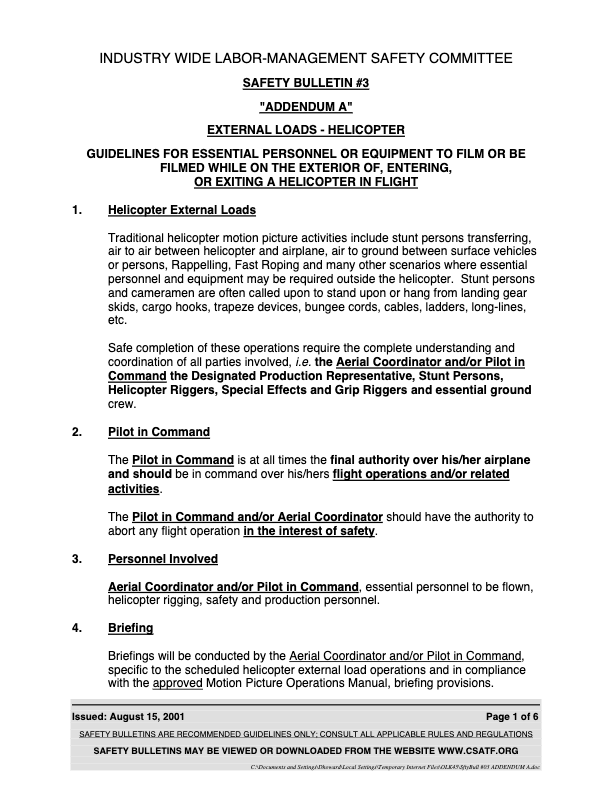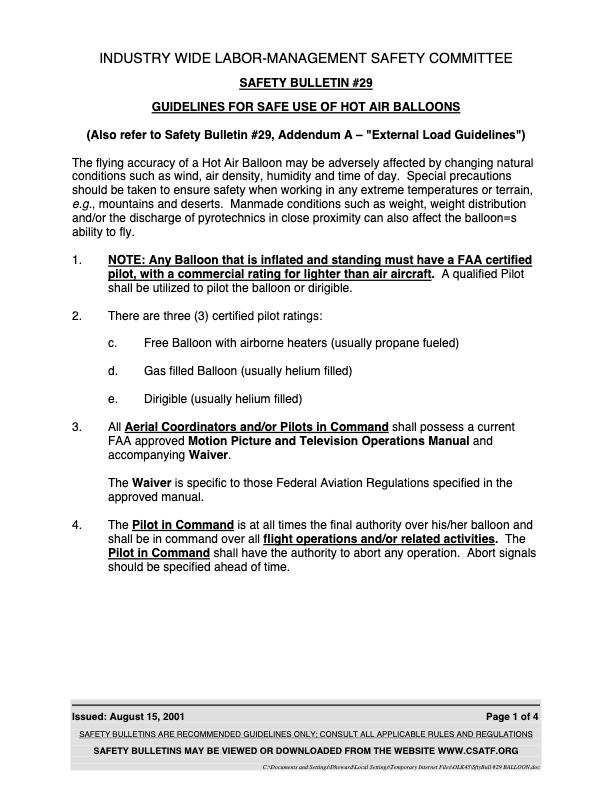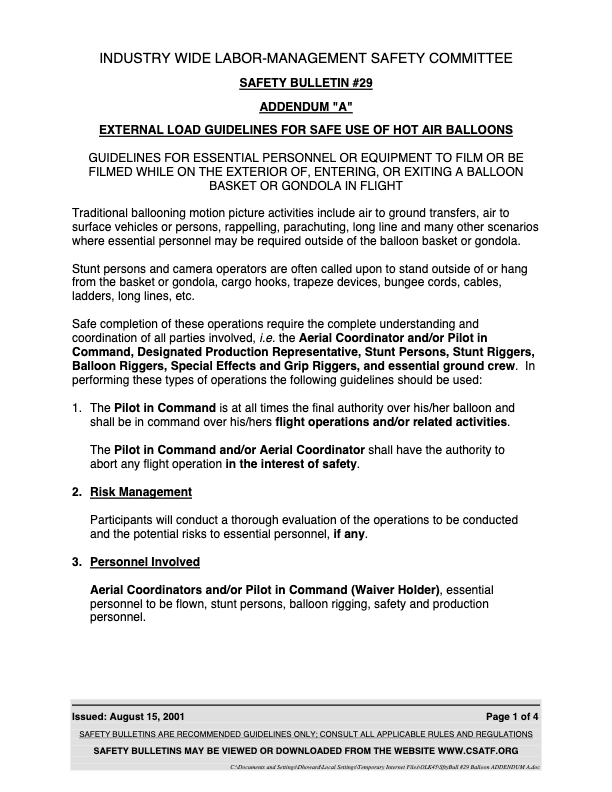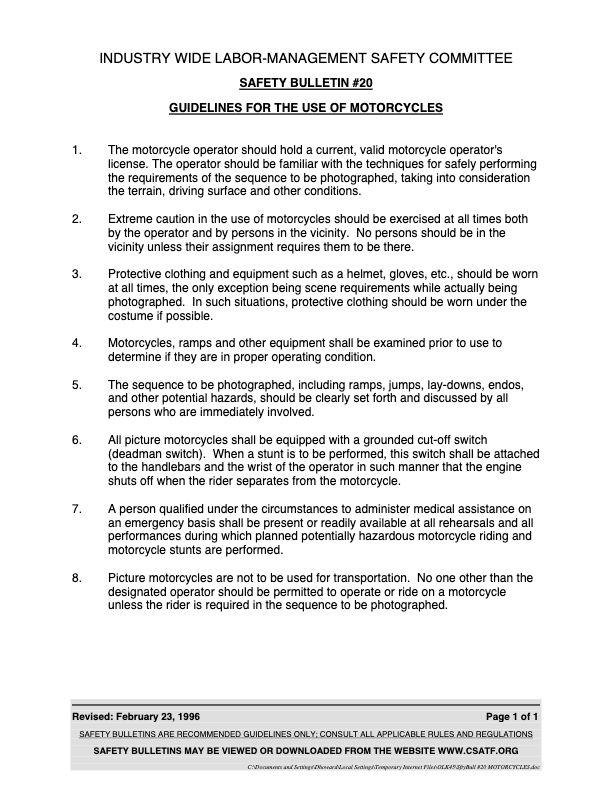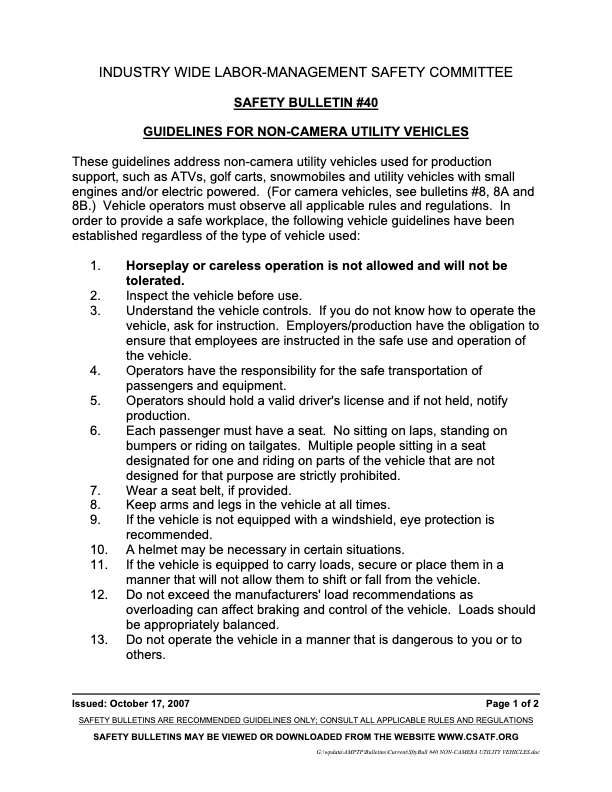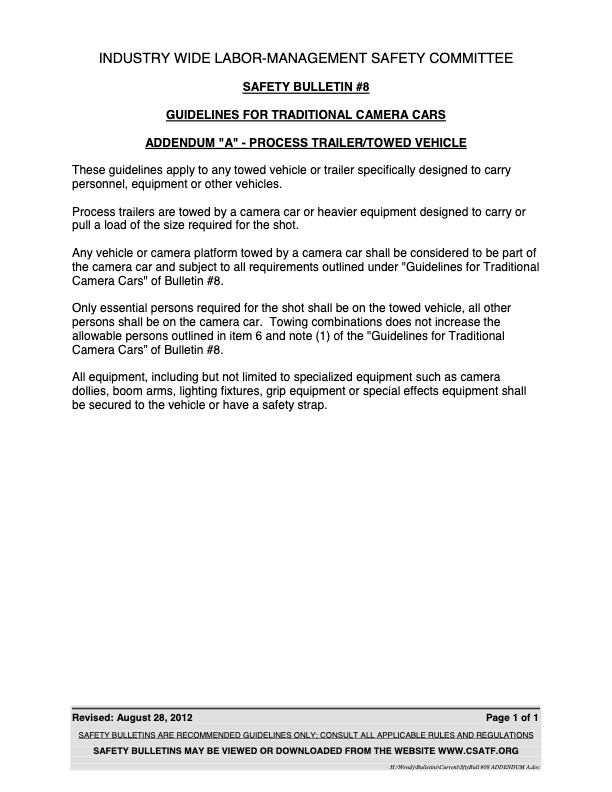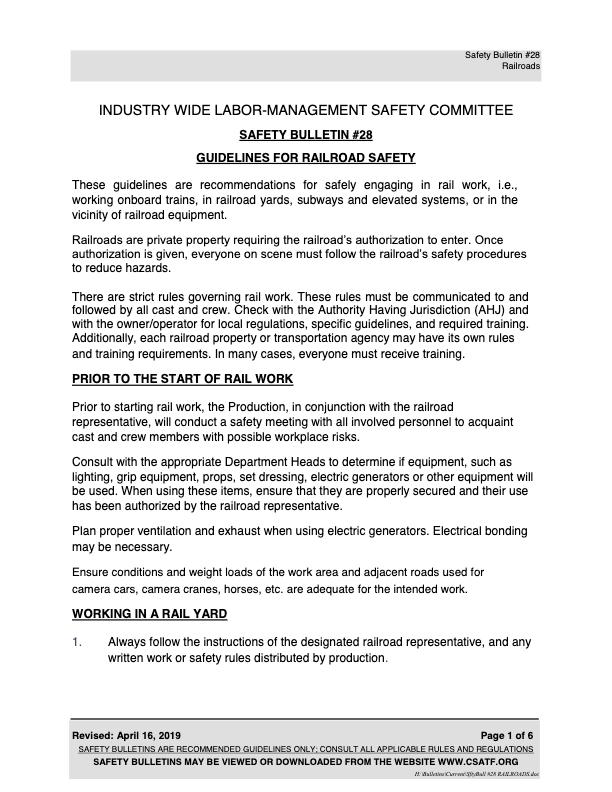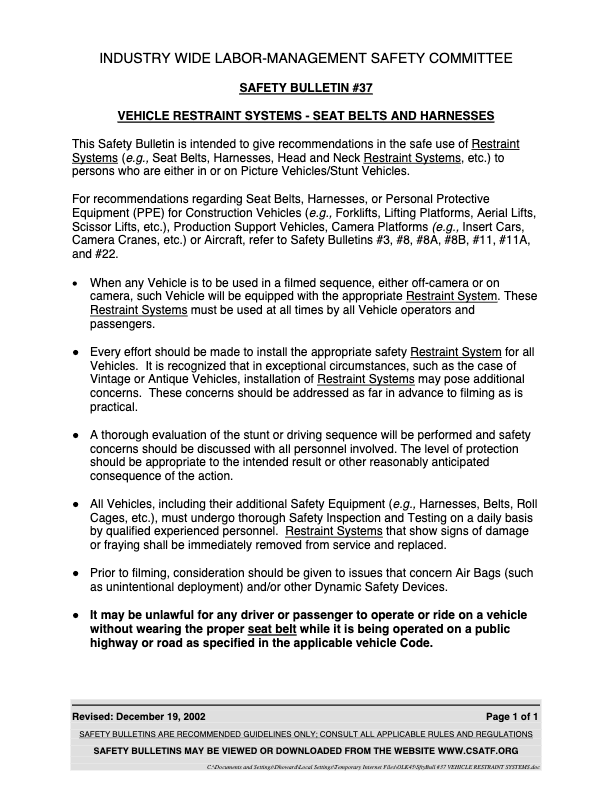Safety Bulletin
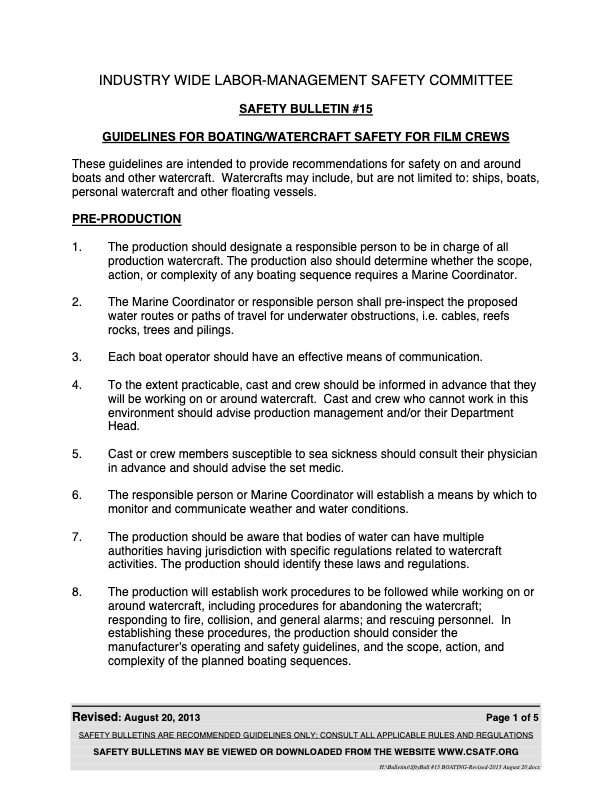
Guidelines
These guidelines are intended to provide recommendations for safety on and around boats and other watercraft. Watercrafts may include, but are not limited to: ships, boats, personal watercraft and other floating vessels.
Pre-Production
- The production should designate a responsible person to be in charge of all production watercraft. The production also should determine whether the scope, action, or complexity of any boating sequence requires a Marine Coordinator.
- The Marine Coordinator or responsible person shall pre-inspect the proposed water routes or paths of travel for underwater obstructions, i.e. cables, reefs rocks, trees and pilings.
- Each boat operator should have an effective means of communication.
- To the extent practicable, cast and crew should be informed in advance that they will be working on or around watercraft. Cast and crew who cannot work in this environment should advise production management and/or their Department Head.
- Cast or crew members susceptible to sea sickness should consult their physician in advance and should advise the set medic.
- The responsible person or Marine Coordinator will establish a means by which to monitor and communicate weather and water conditions.
- The production should be aware that bodies of water can have multiple authorities having jurisdiction with specific regulations related to watercraft activities. The production should identify these laws and regulations.
- The production will establish work procedures to be followed while working on or around watercraft, including procedures for abandoning the watercraft; responding to fire, collision, and general alarms; and rescuing personnel. In establishing these procedures, the production should consider the manufacturer’s operating and safety guidelines, and the scope, action, and complexity of the planned boating sequences.
- The responsible person or Marine Coordinator will determine who will be assigned the responsibility for conducting a head count. A head count should be conducted when the amount of cast and crew, the size and design of the vessel, the intended operations aboard the vessel, or the environmental conditions make an immediate visual assessment of cast and crew impractical.
- Each watercraft shall be equipped with all United States Coast Guard required safety equipment for the vessel type and size, including approved Personal Floatation Devices (PFD) for each person aboard the watercraft.
- The responsible person or Marine Coordinator shall check the number, rating, and condition of all PFDs and, if required, rescue devices and safety equipment needed on board and dockside.
- The responsible person or Marine Coordinator should determine the occupancy and weight limits for each watercraft. Only essential personnel and equipment should be on board.
- The responsible person or Marine Coordinator will approve how equipment will be rigged and secured to the watercraft.
- All shore power and portably supplied AC power shall be protected by Ground Fault Circuit Interrupters (“GFCI”).
- The watercraft owner/operator should pre-approve generator use. Generators need to be secured, and exhaust properly vented. Generators also must be equipped with a charged and readily accessible fire extinguisher.
- The responsible person or Marine Coordinator needs to approve all areas where fuel is stored and used.
Prior to Boarding
- Safety Meetings – The First Assistant Director (1st A.D.), along with the responsible person or Marine Coordinator, shall conduct a safety meeting with all cast and crew. Safety meeting topics may include, but are not limited to: work procedures; emergency procedures; and known or potential hazards.
- All persons should wear closed-toe, non-skid, rubber-soled shoes when working on watercraft.
- Avoid clothing, jewelry or loose items that can get caught in machinery or rigging, or impede watercraft transfers.
- Wear clothing appropriate to the anticipated environmental conditions, such as a brimmed hat, sunglasses, and long-sleeved shirt. Apply and reapply sunblock as needed.
- A head count shall be taken when applicable, the Marine Coordinator or his/her designee shall conduct a head count as cast and crew board the vessel. A similar head count shall be conducted upon disembarking.
Boarding
- Stand clear of the watercraft and away from the dock edge during docking procedures. Do not attempt to board until the watercraft is secured to the dock and a member of the watercraft crew gives instructions and permission to board.
- Never place arms, legs or any other part of the body between the watercraft and dock, between two watercrafts, or between the lines used to secure watercrafts.
- When boarding, only the designated boarding area or device shall be used. Do not step over rails, gunwales (side of boat), or lifelines without permission.
- Do not block access to the watercraft’s rigging, ladders, or emergency-access hatches. Stow gear and equipment in pre-approved areas only.
Once on Board
- When underway or anchored or docked in choppy water, keep one hand free at all times to hold onto the watercraft or railing.
- PFDs and other floatation devices must be available for all cast/crew members. If you are instructed to put on a PFD, do so and be sure it is properly secured.
- Only personnel designated by the responsible person or Marine Coordinator should operate the watercraft’s machinery, valves, switches, and other equipment.
- No one should straddle the gunwale or sit with their legs dangling over the side of the watercraft, unless it is required for production or vehicle operation and the necessary safety precautions are in place.
- Always ensure an emergency escape route is available, including while positioning and securing gear and equipment.
- Do not throw any waste overboard.
- The private quarters, engine room, and the wheelhouse/bridge are off limits to the cast and crew, unless approved.
- Smoking and open flames are not allowed, unless specifically required for a scene and necessary safety precautions are in place.
- Marine toilets may not be as efficient as those on land. Do not flush objects other than approved toilet tissue.
- Cast and crew should be aware of sudden and drastic movement from moving parts, i.e. overhead booms, winches, additional rigging lines, etc., which may hit and injure an unsuspecting person.
- Performers requested to operate watercraft on-camera should be provided appropriate training. When a performer is operating the watercraft, emergency procedures to reestablish operational control of the on-camera watercraft should be in place.
Sea Sickness
- If you feel nauseous, do not go below the deck. Instead, stay on deck in the fresh air, look at the horizon line, and contact the set medic immediately.
- Eat soda crackers or plain bread and drink soda water when sea-sickness symptoms are present.
- Cast and crew who have taken sea sickness medicine should promptly advise the set medic.
Boat-to-Boat Transfers
- Do not attempt to transfer until watercraft personnel have designated the transfer points and have given the command to transfer.
- Stand clear of the transfer-craft, tie-up area until the transfer craft is secured to the watercraft.
- Prior to transferring to another watercraft, allow watercraft personnel to assist in the transfer of gear and equipment. Use two hands to steady yourself when transferring to the other watercraft.
Boat-to-Beach Transfers
- Because proper timing is essential for the watercraft operator to safely enter and exit from a beach, the watercraft operator will advise the cast and crew on boat- to-beach transfer procedures.
When at Anchor or at Sea
- If you see someone fall into the water, yell, “MAN OVERBOARD,” as loudly as possible and point in the direction of that person. DO NOT take your eyes off that person. Continue pointing until watercraft personnel take over.
- Stay out of the water, unless you are part of a planned scene.


